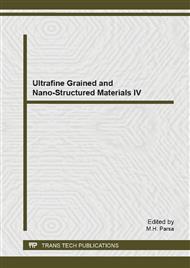p.862
p.869
p.874
p.879
p.884
p.889
p.897
p.902
p.907
Production of Ultrafine Grained API X70 Steel with Controlled Rolling
Abstract:
Development of industries in recent years reveals the essential need to the microalloyed steels with high strength and good ductility. Refinement of Ferrite grains by thermomechanical Treatment is the only lower cost effective method to improve strength and toughness spontaneously in this type of steels. API X70 steel belongs to high strength microalloyed steel group. The manufacturing process of this steel is controlled rolling which is a kind of thermomechanical treatment and it is considered as a grain refining method. In this research, three specimens of API X70 steel were experimentally rolled in order to achieve ultrafine grained microstructure. Rolling operations are designed in such a way that the rolling of these specimens finished at 846, 823 and 800°C. Results of the experiments were analyzed by mechanical tests and microstructures observations. The microstructure observations show that decreasing of finish rolling temperature causes decrease in Ferrite grain size. Results also show that rolling of API X70 steel in the vicinity of Ar3 temperature and high strain rates lead to ultrafine Ferrite grains in microstructure. This is due to the transformation of work hardened austenite to Ferrite. On the other side, Tensile and impact tests show that decreasing of finish rolling temperature causes increasing in yield and tensile strength and also improves the toughness.
Info:
Periodical:
Pages:
884-888
Citation:
Online since:
November 2013
Price:
Сopyright:
© 2014 Trans Tech Publications Ltd. All Rights Reserved
Share:
Citation:


